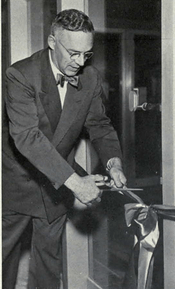Richard G. Folsom

Richard Gilman Folsom (1907 – 1996) was the twelfth president of Rensselaer Polytechnic Institute. He was born to Harry G. Folsom and Mabel Folsom [1]on February 3, 1907 in Los Angeles, California. He received B.S., M.S. and P.h.D. degrees in mechanical engineering from the California Institute of Technology (in 1928, 1929 and 1932, respectively). His P.h.D. thesis was entitled An experimental investigation of the phenomena produced by the highly turbulent flow of water past a series of sharp obstacles.[2] In 1933, he became an instructor in mechanical engineering at the University of California at Berkeley, rising to full professor. From 1947-1953, he was chairman of the mechanical engineering department and from 1952-1953 he was also director of the mechanical engineering laboratories.[3] From 1953-1958, he was director of the Engineering Research Institute at the University of Michigan.
In 1958, he was appointed president of Rensselaer. In 1960, the institute established a department of nuclear engineering.[4] The institute also began to enroll women during this time. Previously, the institute had awarded degrees to only 69 women, the first being in 1945.[5] In 1971, he retired from the presidency. In 1976, a new library that had been started during his presidency was named in his honor. He died on March 11, 1996.
| Academic offices | ||
|---|---|---|
| Preceded by Livingston W. Houston |
President of Rensselaer Polytechnic Institute 1958 – 1971 |
Succeeded by Richard J. Grosh |
References
- ↑ http://pilot.familysearch.org/recordsearch/start.html#birthYear=1907&p=recordResults&givenName=richard&searchType=exact&surname=folsom 1910 U.S. census, Los Angeles Assembly District 70, Los Angeles, California
- ↑ Richard Gilman Folsom thesis
- ↑ Caltech Engineering and Science Alumni News
- ↑ "News Notes: Classroom and Campus", New York Times, June 12, 1960
- ↑ "Rensselaer Open in Full to Women", New York Times, October 19, 1960
| |||||||||||||||||||||||